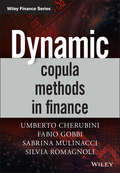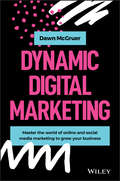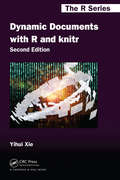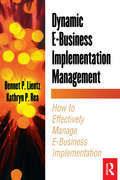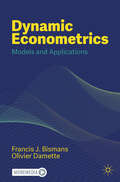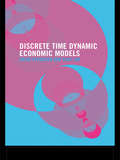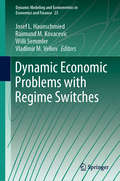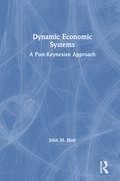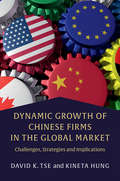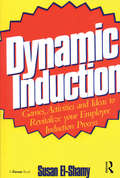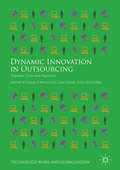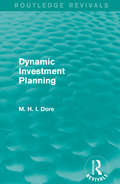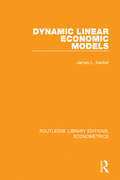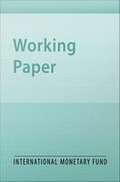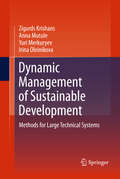- Table View
- List View
Dynamic Competitive Strategy: Turning Strategy Upside Down
by Tony Dr GrundyDynamic Competitive Strategy by best –selling author Dr Tony Grundy casts a radically new light on Competitive Strategy by showing you the dynamic dimension of existing strategy tools and new ones created to deal with rapid innovation and turbulent change. He shows us refreshing and challenging ways of developing strategy, including: Agile approaches to Strategy and Planning The art of the Cunning Plan –with 101 ways of being innovative The alien approach: how might an alien see your industry and business? A whole new set of dynamic strategy tools Scenario storytelling and the art of mental time travel How emotional value can leverage competitive advantag Dynamic stakeholder analysis and influencing He also includes case studies of Arsenal, Brexit, Dyson, Metrobank, Tesco, the infamous honey badger and others from everyday life. This book provides an overall theory and a wealth of practical guidance based on 30 years of Strategy Consulting and Management Research and Teaching that will transform your thinking about strategy. Tony truly "turns strategy upside down," as he does on the cover.
Dynamic Copula Methods in Finance
by Umberto Cherubini Sabrina Mulinacci Silvia Romagnoli Fabio GobbiThe latest tools and techniques for pricing and risk managementThis book introduces readers to the use of copula functions to represent the dynamics of financial assets and risk factors, integrated temporal and cross-section applications. The first part of the book will briefly introduce the standard the theory of copula functions, before examining the link between copulas and Markov processes. It will then introduce new techniques to design Markov processes that are suited to represent the dynamics of market risk factors and their co-movement, providing techniques to both estimate and simulate such dynamics. The second part of the book will show readers how to apply these methods to the evaluation of pricing of multivariate derivative contracts in the equity and credit markets. It will then move on to explore the applications of joint temporal and cross-section aggregation to the problem of risk integration.
Dynamic Digital Marketing: Master the world of online and social media marketing to grow your business
by Dawn McGruer8 powerful ways to market your business online to consistently generate an abundance of leads that convert into profitable customers. Dynamic Digital Marketing teaches any business or individual how to increase online visibility and presence, attract their target audience, generate leads, and convert them into profitable customers. Author Dawn McGruer is an expert at making businesses and brands shine online. She is passionate about helping entrepreneurs and businesses maximise their digital marketing profits by developing digital skills which scale and grow their businesses and accelerate their success. Most entrepreneurs and businesses fully understand the importance of digital marketing, yet many do not know where to start or, worse, continue to spend time, money, and effort on strategies that fail to provide the best results for their investment. To remedy this situation, Dawn developed her multi-award-winning digital marketing framework, Dynamic Digital Marketing Model. Offering step-by-step guidance, this book shows you how to use this model to market your business online whilst transforming yourself into a proficient digital marketer. This must-read book will help you: Gain invaluable insights on what works – and what doesn’t – based on the author’s 20 years’ experience in digital marketing Avoid pitfalls and missteps by implementing the same proven success strategies used by key influencers Harness the power of search engine optimisation (SEO), social media, content marketing, online video, and more Amplify your brand, cultivate customers, and increase profits Incorporate e-mail marketing, customer analytics, strategic web design, and influencer partnerships in your overall digital marketing strategy Dynamic Digital Marketing: Master the world of online and social media marketing to grow your business is an indispensable resource for business leaders, business owners, marketing and sales professionals, digital strategists and consultants, entrepreneurs, and students in business and marketing programmes.
Dynamic Documents with R and knitr (Chapman & Hall/CRC The R Series #12)
by Yihui XieQuickly and Easily Write Dynamic Documents Suitable for both beginners and advanced users, Dynamic Documents with R and knitr, Second Edition makes writing statistical reports easier by integrating computing directly with reporting. Reports range from homework, projects, exams, books, blogs, and web pages to virtually any documents related to statistical graphics, computing, and data analysis. The book covers basic applications for beginners while guiding power users in understanding the extensibility of the knitr package. New to the Second Edition A new chapter that introduces R Markdown v2 Changes that reflect improvements in the knitr package New sections on generating tables, defining custom printing methods for objects in code chunks, the C/Fortran engines, the Stan engine, running engines in a persistent session, and starting a local server to serve dynamic documents Boost Your Productivity in Statistical Report Writing and Make Your Scientific Computing with R Reproducible Like its highly praised predecessor, this edition shows you how to improve your efficiency in writing reports. The book takes you from program output to publication-quality reports, helping you fine-tune every aspect of your report.
Dynamic Drive: The Purpose-Fueled Formula for Sustainable Success
by Molly FletcherIn a world fixated on fleeting success, Molly Fletcher, renowned keynote speaker, podcast host, and entrepreneur, invites you to challenge the status quo and redefine your understanding of drive so that you can achieve greater fulfillment and purpose-driven success. This isn&’t just another self-help theory: Dynamic Drive is your practical guide to unlocking your true potential. Through her decades of experience working with top athletes and peak performers across industries, renowned keynote speaker and leadership expert Molly Fletcher has created a proven formula backed by research that outlines the seven keys to sustainable success. The truth is fulfillment doesn&’t come from setting and accomplishing goals in isolation. It comes from Dynamic Drive—a holistic approach that connects all parts of you with your purpose and allows you to engage in meaningful growth, both personally and professionally. Unlike traditional approaches that dilute drive into a mere means to an end, which can lead to burnout, Dynamic Drive is a way of life, a mindset. It&’s about figuring out the parts of your life where you are playing small or safe or are dissatisfied. Dynamic Drive is the process by which we implement and sustain intentional change. The greatest reward isn&’t in what you achieve, but who you become in the process. Your path to sustained high performance in all areas of your life begins here. This is your manual for an aligned, joyful, and relentless pursuit of a better you.
Dynamic E-Business Implementation Management
by Bennet Lientz Kathryn ReaImplementing e-business requires a dynamic approach that can respond to changes in technology, management direction, customer and supplier behavior, and competition. Many traditional project management methods don't work with e-business. This book presents proven real world management methods that are adaptive, dynamic, and flexible in an e-business environment. It tackles the central issues of e-business: the burgeoning market for "buy-side" extranet/Internet procurement and supply chain management/business-to-business, Web-based transactions.
Dynamic Econometrics: Models and Applications
by Francis J. Bismans Olivier DametteThis textbook for advanced econometrics students introduces key concepts of dynamic non-stationary modelling. It discusses all the classic topics in time series analysis and linear models containing multiple equations, as well as covering panel data models, and non-linear models of qualitative variables. The book offers a general introduction to dynamic econometrics and covers topics including non-stationary stochastic processes, unit root tests, Monte Carlo simulations, heteroskedasticity, autocorrelation, cointegration and error correction mechanism, models specification, and vector autoregressions. Going beyond advanced dynamic analysis, the book also meticulously analyses the classical linear regression model (CLRM) and introduces students to estimation and testing methods for the more advanced auto-regressive distributed lag (ARDL) model. The book incorporates worked examples, algebraic explanations and learning exercises throughout. It will be a valuable resource for graduate and postgraduate students in econometrics and quantitative finance as well as academic researchers in this area.
Dynamic Economic Analysis
by Gerhard SorgerFocusing on deterministic models in discrete time, this concise yet rigorous textbook provides a clear and systematic introduction to the theory and application of dynamic economic models. It guides students through the most popular model structures and solution concepts, from the simplest dynamic economic models through to complex problems of optimal policy design in dynamic general equilibrium frameworks. Chapters feature theorems and practical hints, and 75 worked examples highlight the various methods and results that can be applied in dynamic economic models. Notation and formulation is uniform throughout, enabling students to easily discern the similarities and differences between various model classes. Chapters include more than 60 exercises for students to self-test their analytical skills, and password-protected solutions are available for instructors on the companion website. Assuming no prior knowledge of dynamic economic analysis or dynamic optimization, this textbook is ideal for advanced students in economics.
Dynamic Economic Decision Making
by John SilviaA comprehensive analysis of the macroeconomic and financial forces altering the economic landscapeFinancial decision-making requires one to anticipate how their decision will not only affect their business, but also the economic environment. Unfortunately, all too often, both private and public sector decision-makers view their decisions as one-off responses and fail to see their decisions within the context of an evolving decision-making framework.In Decision-Making in a Dynamic Economic Setting, John Silvia, Chief Economist of Wells Fargo and one of the top 5 economic forecasters according to Bloomberg News and USA Today, skillfully puts this discipline in perspective.Details realistic, decision-making approaches and applications under a broad set of economic scenariosAnalyzes monetary policy and addresses the impact of financial regulationsExamines business cycles and how to identify economic trends, how to deal with uncertainty and manage risk, the building blocks of growth, and strategies for innovationDecision-Making in a Dynamic Economic Setting details the real-world application of economic principles and financial strategy in making better business decisions.
Dynamic Economic Models in Discrete Time: Theory and Empirical Applications
by Brian Ferguson Guay LimThis new book will be welcomed by econometricians and students of econometrics everywhere. Introducing discrete time modelling techniques and bridging the gap between economics and econometric literature, this ambitious book is sure to be an invaluable resource for all those to whom the terms unit roots, cointegration and error correction forms, ch
Dynamic Economic Problems with Regime Switches (Dynamic Modeling and Econometrics in Economics and Finance #25)
by Willi Semmler Vladimir M. Veliov Raimund M. Kovacevic Josef L. HaunschmiedThis book presents the state of the art in the relatively new field of dynamic economic modelling with regime switches. The contributions, written by prominent scholars in the field, focus on dynamic decision problems with regime changes in underlying dynamics or objectives. Such changes can be externally driven or internally induced by decisions. Utilising the most advanced mathematical methods in optimal control and dynamic game theory, the authors address a broad range of topics, including capital accumulation, innovations, financial decisions, population economics, environmental and resource economics, institutional change and the dynamics of addiction. Given its scope, the book will appeal to all scholars interested in mathematical and quantitative economics.
Dynamic Economic Systems: A Post Keynesian Approach
by John M. BlattThe future of the Common Law judicial system in Hong Kong depends on the perceptions of it by Hong Kong's Chinese population, judicial developments prior to July 1, 1997, when Hong Kong passes from British to Chinese control, and the Basic Law. These critical issues are addressed in this book.
Dynamic Factor Price Equalization & International Income Convergence
by Clinton R. Shiells Joseph FrancoisA report from the International Monetary Fund.
Dynamic Faith Journal
by Jerry FalwellEach day will be a 2-page spread with a summary statement and applications taken from Building Dynamic Faith. Daily guide for the reader to apply Building Dynamic Faith. Includes all of the application exercises from Building Dynamic Faith with room to journal.
Dynamic Formal Epistemology
by Olivier Roy Patrick Girard Mathieu MarionThis volume is a collation of original contributions from the key actors of a new trend in the contemporary theory of knowledge and belief, that we call "dynamic epistemology". It brings the works of these researchers under a single umbrella by highlighting the coherence of their current themes, and by establishing connections between topics that, up until now, have been investigated independently. It also illustrates how the new analytical toolbox unveils questions about the theory of knowledge, belief, preference, action, and rationality, in a number of central axes in dynamic epistemology: temporal, social, probabilistic and even deontic dynamics.
Dynamic Games in Economics
by Vladimir M. Veliov Josef Haunschmied Stefan WrzaczekDynamic game theory serves the purpose of including strategic interaction in decision making and is therefore often applied to economic problems. This book presents the state-of-the-art and directions for future research in dynamic game theory related to economics. It was initiated by contributors to the 12th Viennese Workshop on Optimal Control, Dynamic Games and Nonlinear Dynamics and combines a selection of papers from the workshop with invited papers of high quality.
Dynamic Growth of Chinese Firms in the Global Market: Challenges, Strategies and Implications
by David K. Tse Kineta HungHow have Chinese multinationals benefited from China's economic boom to enable their international expansion? This book is based on many years of original research tracing the emergence, growth and future of Chinese firms in the world economy. The authors seek to provide new perspectives and insights for business executives and graduate students through a comprehensive study of how China's firms globalize and operate, and the implications of this for economic success. Based on detailed case studies and summative examples of successful Chinese firms, Tse and Hung point out their strengths (e.g. making innovations affordable to many developing nations), their weaknesses (products made in China are not highly regarded) and their mistakes (being insensitive to host economy needs and at times corruptive acts). They argue that the world economy would benefit from engaging with Chinese and other emerging economy firms to learn from the strategies they employ to achieve their global reach.
Dynamic Induction: Games, Activities and Ideas to Revitalize your Employee Induction Process
by Susan El-ShamyDynamic Induction: Games, Activities and Ideas to Revitalise Your Employee Induction Process is a practical guide to upgrading your induction process and actively facilitating the new employee's becoming a positive, productive member of the organization as quickly as possible. This informative, straightforward book has been designed to make it simple for you to take action and repair, revitalize or even rebuild your entire new-employee orientation and assimilation procedure into a dynamic and engaging process that will improve communication, co-operation and group cohesiveness. Using a series of assessments, quizzes, charts and checklists, this instructive handbook presents more than 200 ideas and suggestions for enhancing and energizing your complete induction process, starting from the moment a new employee accepts the job. Dynamic Induction also provides you with 50 games and structured activities that can be used to impart work-related information to staff embarking on a new job. These games and activities can be used in all of the instruction-related aspects of your induction process, including planned actions taken to welcome and help the new person as well as specific learning events designed to accelerate the integration of the new employee into the workforce.
Dynamic Innovation in Outsourcing: Theories, Cases And Practices (Technology, Work And Globalization Ser.)
by Julia Kotlarsky Ilan Oshri Leslie P. WillcocksThis book is a guide for achieving innovation through outsourcing. Unpacking the various challenges faced by client firms and suppliers, the authors take the reader through the innovation lifecycle and devise a clear plan to achieve valuable results. Offering practical frameworks and tools to ensure informed decision-making at every stage, this book also includes collaborative structures and metrics to measure outcomes. Written by leading figures in the area of outsourcing, this book offers both the academic rigor and the hands-on experience based on dozens of cases that walk the reader from the very beginning of the outsourcing journey to the successful delivery of transformative innovations.
Dynamic Investment Planning (Routledge Revivals)
by Mohammed H. DoreIn dynamic investment planning the time of investment is a significant issue. By simplifying the mathematical notation, the author of this book seeks to make control theory a practical tool that can be applied to the problem of timing. The book, first published in 1977, begins with an introduction to one important approach to control theory – dynamic programming. Then some of the relevant literature that deals with investment decision-making is reviewed. This is followed by a mathematically formulated planning model. The computational aspects of the model are discussed and a complete computer flow chart is given. The second part of the book gives a thorough application of the theory by means of a detailed case study – the planning of a steel industry. The case study illustrates how a fairly abstract dynamic analysis can be effectively integrated with practical decision-making concerns. This book is ideal for students of economics and business.
Dynamic Linear Economic Models (Routledge Library Editions: Econometrics #10)
by James L. KenkelOriginally published in 1974. This book provides a rigorous and detailed introductory treatment of the theory of difference equations and their applications in the construction and analysis of dynamic economic models. It explains the theory of linear difference equations and various types of dynamic economic models are then analysed. Including plenty of examples of application throughout the text, it will be of use to those working in macroeconomics and econometrics.
Dynamic Loan Loss Provisions in Uruguay: Properties, Shock Absorption Capacity and Simulations Using Alternative Formulas
by Torsten WezelA report from the International Monetary Fund.
Dynamic Locational Phases of Economic Activity in the Globalized World
by Toshiharu IshikawaThis book clarifies the mechanisms of economicglobalization in changing industries' locations and shows how industries' locations have changedthrough those mechanisms. First, the book deals with the retailing industry. Introducing the concept of a contactprice into the market area analysis, it is shown in Part I that retailers'market areas and prices are changed in different ways by a reduction oftransportation costs. The mechanism of these changes is explained by checkingthe contact prices at apexes of the retailers' market areas. Then the book movesto the manufacturing industry and deals with a firm's production process. Part IIof the book shows the manner in which the production volume of factories withinan agglomeration is decreased as the number of factories within theagglomeration increases. Subsequently, considering the fact that many productionfactories depart from agglomerations to other sites to reduce production costs,a method of searching for a factory's new site is proposed in which a firm can seekout an optimal location of a factory in a short period of time. By referring toa chaotic phenomenon, a firm sets a locationprospective area in a large geographical area and selects an optimallocation within that area. In the third part of the book the city system is thefocus. Part III elucidates the theoretical formation of a city system andanalyzes structural changes of a city system due to a reduction oftransportation costs. The mechanism of the change is explained by a flexible market area theory which studiesa city system by using the market areas established in the free-entry equilibrium. Then, the economic relationships between the cities within a city system areexamined from the point of view of the land rent in the cities' areas. Thisanalysis shows the influences of a change in the largest city on other cities. Finally,the relationships between a city system and regional performance are examinedusing real data. The examination shows that the city system reveals the regionalperformance.
Dynamic Macroeconomics (The\mit Press Ser.)
by George AlogoskoufisAn advanced treatment of modern macroeconomics, presented through a sequence of dynamic equilibrium models, with discussion of the implications for monetary and fiscal policy.This textbook offers an advanced treatment of modern macroeconomics, presented through a sequence of dynamic general equilibrium models based on intertemporal optimization on the part of economic agents. The book treats macroeconomics as applied and policy-oriented general equilibrium analysis, examining a number of models, each of which is suitable for investigating specific issues but may be unsuitable for others.After presenting a brief survey of the evolution of macroeconomics and the key facts about long-run economic growth and aggregate fluctuations, the book introduces the main elements of the intertemporal approach through a series of two-period competitive general equilibrium models—the simplest possible intertemporal models. This sets the stage for the remainder of the book, which presents models of economic growth, aggregate fluctuations, and monetary and fiscal policy. The text focuses on a full analysis of a limited number of key intertemporal models, which are stripped down to essentials so that students can focus on the dynamic properties of the models. Exercises encourage students to try their hands at solving versions of the dynamic models that define modern macroeconomics. Appendixes review the main mathematical techniques needed to analyze optimizing dynamic macroeconomic models. The book is suitable for advanced undergraduate and graduate students who have some knowledge of economic theory and mathematics for economists.
Dynamic Management of Sustainable Development
by Irina Oleinikova Anna Mutule Yuri Merkuryev Zigurds KrishansDynamic management of systems development is a precondition for the realization of sustainable system development. This approach allows for the usage of systems theory methods that take into consideration the interaction of decisions made over time and space. A characteristic feature of this kind of method is that the process of sophisticated object development over time is examined for optimal decision selection. This requires the application of modelling methods that represent properties of the developing objects, high speed calculation methods for the estimation of technical and economic characteristics, as well as effective optimization methods. Dynamic Management of Sustainable Development presents a concise summary of the authors' research in the area of dynamic methods analysis of technical systems development. Along with systematic illustration of mathematical methods, considerable attention is drawn to practical realization and applications. Dynamic Management of Sustainable Development will be helpful for scientists involved in the mathematical modelling of large technical systems development and for engineers working in the area of large technical systems planning.

